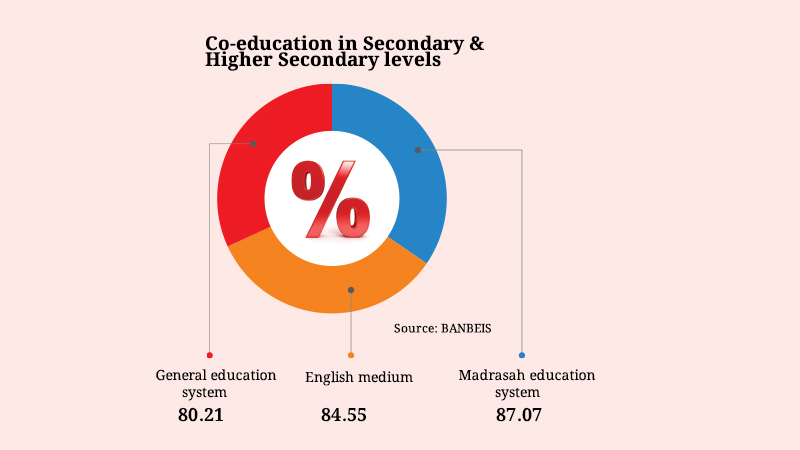Bangladesh
primarily has four types of education systems—General, Madrasah, Technical, and
English medium. Among them, co-education (boys and girls studying in the same
classroom) is most prevalent in the Madrasah education system. In Madrasahs,
the secondary level is known as Dakhil, the higher secondary level as Alim,
undergraduate as Fazil, and postgraduate as Kamil. The age range of students in
these institutions generally spans from 11 to 27 years. Nearly 87 percent of Madrasah
institutions offer co-education. In contrast, the general education system has
the lowest prevalence, with co-education available in around 80 percent of institutions.
Education
experts believe that co-education is relatively more effective compared to
separate education systems for boys and girls. Students in co-educational
systems tend to perform better in their careers than those in specialized
institutions. Additionally, students who grow up in co-education environments
develop mutual respect and leadership skills.
According
to the Bangladesh Education Statistics 2023 from the Bangladesh Bureau of Educational Information and Statistics (BANBEIS), 80.21 percent of general education institutions from secondary school to college (including postgraduate levels in National University-affiliated institutions) offer co-education. In English-medium institutions, the rate is 84.55 percent. On the other hand,
87.07 percent of Madrasahs have co-education facilities. BANBEIS did not
provide any data regarding co-education in technical institutions.
Dr.
Md. Abdus Salam, professor at the Institute of Education and Research at Dhaka
University, told Bonik Barta, “In the society we live in, we need to
communicate with both men and women in our daily lives. When a student only
attends a specialized institution for boys or girls, they often fall behind in
this aspect. Growing up in a specialized environment may cause some students to
feel uncomfortable communicating with the opposite gender. This can affect
their personal and professional lives. However, students in co-education
systems are generally ahead in this regard.”
He
further explained, “Studying together fosters mutual respect among students.
They also learn about the realities of society. The mutual respect between men
and women that should exist is something they get to learn and practice during
their educational journey. This helps them adapt and succeed in their future
lives. Moreover, understanding the psychology of both genders makes it easier
for them to take on leadership roles.”
According
to BANBEIS data, there are currently 20,448 secondary-level educational
institutions in the country. Of these, 3,285 are for girls only, while 305 are
for boys. A total of 16,415 schools offer co-education, which accounts for
80.27 percent of all schools. Additionally, 443 schools have ‘separate
co-education’ systems (separate campuses for boys and girls).
BANBEIS
data also shows that there are 6,511 Dakhil-level Madrasahs. Of these, 976 are
for girls, and 12 are for boys. Co-education is offered in 5,512 institutions,
accounting for approximately 84.66 percent. In addition, 11 institutions have a
‘separate co-education’ system.
Dr.
Tania Haque, professor of Women and Gender Studies at Dhaka University, said, “Our
society is not solely male or female. When children are educated in a co-education system, they learn to accept this diversity. Growing up with everyone fosters the practical practice of mutual respect. Co-education also
instills an understanding that everyone in society deserves equal opportunities
and rights.”
She
added, “There should be diversity in society. Preferences and needs vary from
person to person. Because of this diversity, both co-educational and
specialized institutions for boys and girls are necessary.”
Like
at the school level, Madrasah education leads in co-education at the college
level as well. There are 4,821 institutions from higher secondary to
postgraduate levels across the country. Among them, 781 are for girls, and 34
are for boys. A total of 3,864 institutions offer co-education, accounting for
approximately 80.18 percent of all institutions. Additionally, 142 institutions
have ‘separate co-education’ systems.
There are 2,748 madrasahs at the Alim to Kamil level. Among them, 149 are for
girls and 23 for boys. Co-education is available in 2,550 institutions,
accounting for approximately 92.80 percent. Additionally, 26 institutions have
a ‘separate co-education’ system.
Professor
Dr. Md. Shamsul Alam, Vice Chancellor of the Islamic Arabic University (IAU),
said, “Islam encourages women’s education. A large number of female students
are enrolled in our country’s Madrasahs. In urban areas, there are often
separate campuses for female students. In rural areas, however, classes are
often conducted together. Madrasahs follow Islamic principles closely, and
these institutions ensure education for students while adhering to those
principles.”

